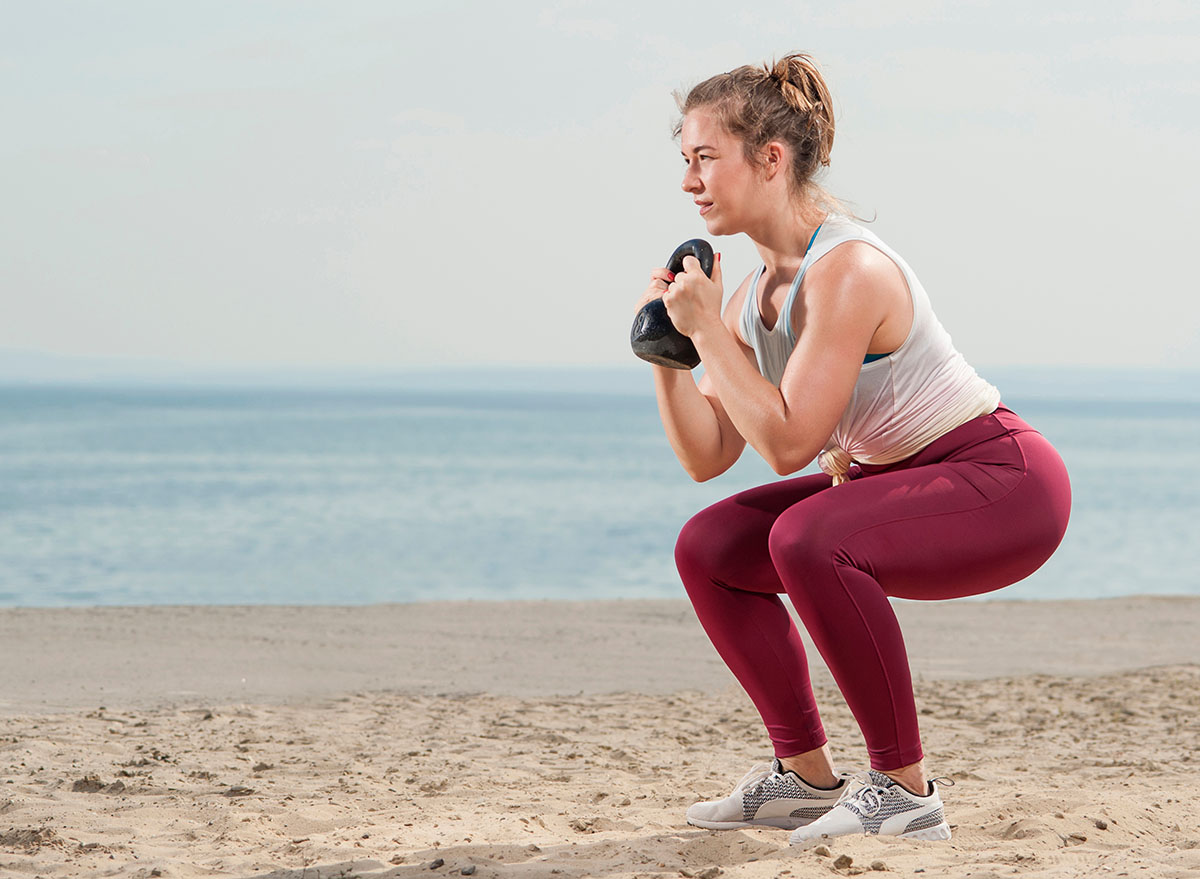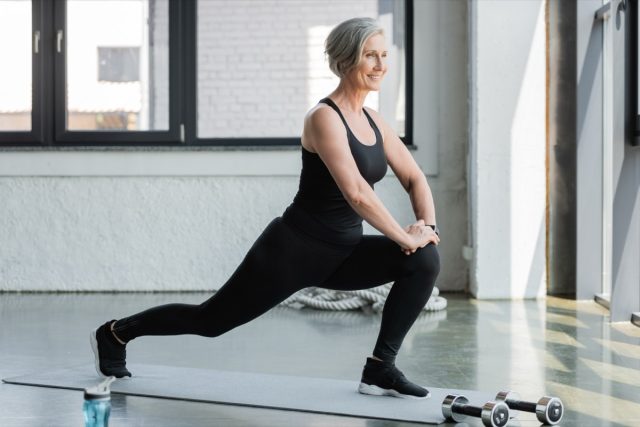6 Quick Moves That Build Strength Faster Than 30-Minute Gym Sessions After 45

Some people think you need an hour-long gym routine to get strong after 45, but your muscles care more about effort and movement quality than time spent wandering between machines. The truth is, short and focused workouts can pack a bigger punch, especially when built around compound, total-body movements that wake up your strength from head to toe.
When you move with purpose, even a 15-minute session can feel like a full-blown challenge. The key is choosing exercises that engage multiple joints and muscle groups simultaneously. These compound moves build strength, coordination, and balance all at once, making every rep more efficient.
Consistency also plays a massive role after 45. The more you move, the better your body maintains muscle, bone density, and mobility. Short sessions remove the excuses because they are quick, efficient, and practical enough to see real progress when done a few times a week.
The following six quick moves deliver maximum strength-building benefits without draining your time or energy. You will hit every major muscle group, boost metabolism, and walk away feeling stronger, steadier, and ready to take on anything your day throws at you.
Quick Move #1: Lunges
Lunges strengthen your lower body and balance system simultaneously. By training one leg at a time, they expose weaknesses and improve stability from the ground up. This single-leg focus helps your hips, knees, and ankles work together in coordination, keeping your joints strong and movement patterns smooth. Lunges also engage your glutes and core, which play a significant role in preventing lower back discomfort and improving posture.
Muscles Trained: Quads, hamstrings, glutes, calves, core
How to Do It:
- Stand tall with your feet hip-width apart and core braced.
- Step forward with your right foot and lower your hips until both knees bend to 90 degrees.
- Keep your chest lifted and your front heel planted throughout the movement.
- Drive through your front foot to return to a standing position.
- Repeat on the left leg.
- Maintain a steady rhythm and avoid rushing each rep.
Recommended Sets and Reps: Perform 3 sets of 10 to 12 reps per leg. Rest for 45 seconds between sets.
Best Variations: Reverse Lunge, Walking Lunge, Lunge with Rotation
Form Tip: Keep your torso upright and push through your heel to fully engage your glutes, avoiding stress on your knees.
Quick Move #2: Romanian Deadlifts
Romanian Deadlifts (RDLs) develop strength in the muscles that protect your spine and improve athletic performance. The hip-hinge pattern teaches you how to lift safely, which translates to real-life movements like bending to pick up groceries or lifting a suitcase. Over time, RDLs improve hamstring flexibility, glute strength, and core stability, all of which support long-term movement efficiency and reduce the risk of injury.
Muscles Trained: Hamstrings, glutes, lower back, core
How to Do It:
- Stand with your feet shoulder-width apart, holding dumbbells or a barbell in front of your thighs.
- Brace your core and keep your shoulders back and down.
- With a soft bend in your knees, hinge at your hips, and push them backward as the weights lower down your legs.
- Stop when you feel a deep stretch in your hamstrings, keeping your back flat and chest tall.
- Drive your hips forward and squeeze your glutes as you return to standing.
- Control the tempo, both lowering and lifting, to stay in tension.
Recommended Sets and Reps: Perform 3 sets of 10 to 12 reps. Rest 60 seconds between sets.
Best Variations: Single-Leg RDL, Kettlebell RDL, Barbell RDL
Form Tip: Keep the weights close to your body and maintain a neutral spine to protect your lower back and maximize glute recruitment.
Quick Move #3: Single-Arm Rows
Single-arm rows build strength in the muscles that support your spine and shoulders while improving overall posture. Training one arm at a time helps correct imbalances that often develop from years of sitting or one-sided activities. Rows also improve grip strength and pulling power, both of which are essential for maintaining muscle balance during pressing exercises and daily tasks like lifting or carrying objects.
Muscles Trained: Lats, rhomboids, biceps, core
How to Do It:
- Place your right hand and knee on a bench with your left foot on the ground.
- Hold a dumbbell in your left hand with your arm fully extended beneath your shoulder.
- Brace your core and pull the dumbbell toward your ribcage, leading with your elbow.
- Pause for a second at the top and squeeze your shoulder blades toward your spine.
- Lower the weight slowly under control.
- Complete all reps on one side before switching to the other.
Recommended Sets and Reps: Perform 3 sets of 10 to 12 reps per side. Rest 45 seconds between sets.
Best Variations: Supported Dumbbell Row, Kettlebell Row, Resistance Band Row
Form Tip: Avoid twisting your torso. Keep your chest facing the floor and let your back muscles drive the movement.
Quick Move #4: Kettlebell Deadlift
The kettlebell deadlift builds power and reinforces proper hip hinge mechanics, which are essential for developing lower-body strength and maintaining back health. It strengthens your posterior chain while teaching your body to generate force from your hips, not your spine. This movement also boosts grip strength, balance, and posture—three key areas that support lifelong strength.
Muscles Trained: Glutes, hamstrings, lower back, core
How to Do It:
- Stand with your feet hip-width apart and a kettlebell between your feet.
- Push your hips back and bend your knees slightly while keeping your chest lifted.
- Grip the kettlebell handle with both hands and engage your core.
- Drive through your heels to stand tall, squeezing your glutes at the top.
- Lower the kettlebell back to the floor by hinging at your hips again.
- Keep the weight close to your body throughout the movement.
Recommended Sets and Reps: Perform 3 sets of 10 to 15 reps. Rest 60 seconds between sets.
Best Variations: Suitcase Deadlift, Double Kettlebell Deadlift, Elevated Kettlebell Deadlift
Form Tip: Keep your back flat and your eyes forward to maintain alignment. Focus on driving your hips, not pulling with your arms.
Quick Move #5: Goblet Squats
Goblet squats combine strength and posture training into a single, powerful movement. Holding a weight in front of your chest activates your upper back and core, allowing for a deeper and more controlled squat. This move strengthens your legs, boosts coordination, and builds functional power that carries into everything from climbing stairs to athletic performance.
Muscles Trained: Quads, glutes, hamstrings, core
How to Do It:
- Hold a dumbbell or kettlebell close to your chest with both hands.
- Stand with your feet slightly wider than hip-width apart and toes slightly turned out.
- Engage your core and lower into a squat by pushing your hips back and bending your knees.
- Keep your chest upright and elbows inside your knees at the bottom of the squat.
- Drive through your heels to stand tall and squeeze your glutes at the top.
- Keep your breathing steady, exhaling as you rise.
Recommended Sets and Reps: Perform 3 sets of 12 reps. Rest 45 seconds between sets.
Best Variations: Pulse Goblet Squat, Tempo Squat, Heel-Elevated Squat
Form Tip: Keep your chest lifted and heels grounded throughout the movement to maintain stability and range of motion.
Quick Move #6: Plank with Shoulder Taps
Planks with shoulder taps target your entire core while challenging your coordination and shoulder stability. They build deep core endurance that supports your spine and posture throughout the day. The alternating taps force your body to stabilize during movement, training your abs and glutes to resist rotational elements for real-world strength and injury prevention.
Muscles Trained: Core, shoulders, chest, glutes
How to Do It:
- Start in a high plank position with your hands directly under your shoulders.
- Keep your body in a straight line from head to heels and your feet shoulder-width apart.
- Engage your abs and glutes to stay stable.
- Lift your right hand to tap your left shoulder, keeping your hips still.
- Return your right hand to the floor and switch to the other side.
- Continue alternating taps for the full duration, maintaining tight control of your body.
Recommended Sets and Reps: Perform 3 sets of 30 to 45 seconds. Rest 45 seconds between sets.
Best Variations: Elevated Plank Taps, Slow-Motion Shoulder Taps, Weighted Shoulder Taps
Form Tip: Keep your hips square and avoid rocking side to side to fully engage your core.
RELATED: 5 Bodyweight Exercises Men Should Do Every Day To Stay Strong After 40
The Best Tips for Building Strength After 45

Strength after 45 comes from consistency, smart recovery, and movement quality. The goal is not to push harder but to train better and recover more efficiently.
- Focus on the full range of motion: Each rep should be smooth, controlled, and complete.
- Lift with intent: Pay attention to how each muscle works during every exercise.
- Stay consistent: Two to four weekly sessions will keep your strength and metabolism high.
- Recover actively: Walk, stretch, and get plenty of sleep to allow your muscles to rebuild.
- Track your progress: Increase your load, reps, or time under tension over the weeks.
When your workouts are sharp, short, and purposeful, even a handful of moves can outwork a long gym session. Train with precision, stay consistent, and you will continue to get stronger long after 45.